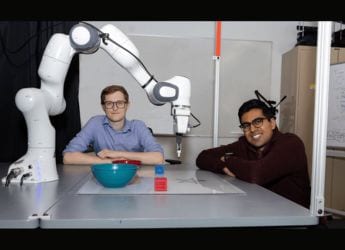- Home
- Mobiles
- Mobiles Features
- Nokia Fans in India at a 'Different Level Than in Any Other Country': HMD Global CMO Pekka Rantala
Nokia Fans in India at a 'Different Level Than in Any Other Country': HMD Global CMO Pekka Rantala

HMD Global Executive Vice President and Chief Marketing Officer, Pekka Rantala
If 2017 was the year that Nokia brand license HMD Global made big waves on the global stage, 2018 will be remembered as the year the brand expanded its product line across various price points. The company launched as many 12 smartphones this year — from the basic Nokia 1, all the way up to the premium Nokia 8 Sirocco, with a bunch of other models in between.
It's no surprise then that the company's senior executives spent the best part of the year flying from one corner of the world to the other. Pekka Rantala, Executive Vice President and Chief Marketing Officer at HMD Global was in India last month on one such trip and we got a chance to spend some time with him to get an update on his second innings with the Nokia brand and the company's fledgling smartphone business.
Though HMD Global announced its decision to bring back Nokia smartphones in December 2016, Rantala reveals how the company executives spent months laying the groundwork for the big announcement.
“[The] first six months [we were] just going around the world — including India — and meeting great customers and [saying] that we are we are soon [coming] here,” he says.
He explains that while everyone obviously recognised the Nokia brand, some people were less than enthusiastic at the prospect of a comeback.
“Some of them, of course, [had] their comments that is that a little bit like yesterday's brand and how much dust is there on the brand,” says Rantala, adding that HMD itself being an unknown entity added to the scepticism.
“So there was a lot confidence building that we had to do in those early days. And probably we have been doing that confidence building during the first and second years also,” he says, emphasising how it's still early days for the company.
Millennials? Their love for Nokia “comes through breast milk”
“So, as you as you may have already heard before, only after the first year we were running the business in 100 countries and during the second year, we have still expanded the business in a couple of new countries,” he continues. “But it has been more of going deeper in each of these countries and widening the distribution [and] opening new partnerships.”
“We have [now] been able now to expand the distribution. We have multiple partners in many markets and this second year also has been a year of, perhaps, maturing the portfolio.”
“During this year alone we brought more than 10 smartphones to the market and right now where we stand is that that I truly believe that we do have a portfolio of Nokia Android smartphones where almost — and I'm underlining almost — every consumer out there, and also every Indian consumer out there, can find their own Nokia phone that they can rely on,” he adds.
Why Indians put Rantala in a good mood
According to Counterpoint research, HMD Global accounted for 5 percent of the smartphone shipments in India in Q3 2018 (IDC puts the number at 2 percent), which made it the seventh biggest smartphone vendor in the country (tenth as per IDC). The company, of course, has a healthy feature phone business as well. We asked Rantala how the Nokia brand has been received in the country's smartphone market.
“[It's been an] amazing welcome by trade and consumers and probably the number one market in the world is India, where — as you know — the brand has always been not only [a] strong brand, but [an] emotional brand,” he says after he spends some time reminiscing about Nokia's early days in India.
“We see fans everywhere in the world celebrating that Nokia is back — absolutely, it's happening — but in India, (chuckles) the amount of passion and how vocal the fans are in India, it's definitely on a different level than in any other country,” he continues.
“You go to Europe — where the brand comes from — [and our fans] are, like, in a silent way happy. Of course, we see them quite actively advocating us in social but in India, it is just on a different level.”
“I always get into good mood when I see the reactions of Indians,” Rantala says.
The European alternative?
HMD's European roots come up on more than one occasion and it's something we've also seen the company embrace publicly during recent launch events, positioning itself as an alternative to the American (well, Apple) and Asian companies that dominate the world's mobile market.
Rantala reveals that while the company almost stumbled upon the fact that its European heritage is something worth playing up, it's definitely been a conscious effort to highlight that fact in recent months.
It was a “purely emotional” decision to join HMD Global
“What we didn't plan was to emphasise and highlight Finnish origin,” he says. “When we have been touring around the world —and not at all in Europe — but when we come to to Asia, we go to Africa, we go to America, our customers are telling us […] that it's so great to have a alternative that comes from the Europe.”
“And we go, really? Oh yes, that's a good thought. Thanks for the input!”
“And now just very recently we have we have [been] more actively — like what I am doing now — emphasising the fact that we are from Europe. That's where our roots are. That's where the brand comes from. That's where the phones are designed.”
“Our head office where I flew off [from] yesterday to [get] here is in Espoo, Finland, where Nokia has had its head office for tens of years. So that I think makes us different and this is something that going forward we will be emphasising more. It's a point of difference and it's also something that defines who we are.”
“Even the European union, Brussels, is very happy that finally — after I would say at least mid-term silent period — there is somebody that comes from Europe and is really trying to challenge the big players that come from Asia or Americas,” he says at another point in the conversation.
25 years to cross a street
Like most of the core team at HMD Global, Rantala spent a large chunk of his career at Nokia, and we ask him if being back at HMD is like reliving the old days.
“Not at all,” he exclaims. “To be honest, I didn't know what to expect also from that perspective because I spent 17 years at Nokia. Then I did something totally different in branded consumer businesses for multiple years. Then I come back.”
“So, I didn't know what to expect. But I can tell you during the past two-and-a-half years, there hasn't been a moment where I would have felt — ‘I have done this before, I know how to do this. You know, I will tell the others, the youngsters.'”
“The whole industry has changed. There are different players. But what has changed most is, of course, the consumers [and] how they behave.”
“We are living and breathing a startup culture, even if we manage to perhaps go worldwide very fast, thanks to the brand, and thanks to the capabilities of our partners. But definitely, it's a totally different working experience.”
“We, of course, [have] very less resources, but we want to have it that way. We want to bring with us all the best things that we learnt from Nokia, all those good things that we learnt from Microsoft, and we also have wanted to unlearn so many things.”
“I always get into good mood when I see the the reactions of Indians”
“The only thing — which is a funny coincidence — but only thing which reminds me of my past at Nokia is that we moved into a new office location one month ago in Espoo, Finland […] If I look out of the window of my office, there is a street and the other side of the street, there is an old office building, and that is the building where I started [in] early 90s to work for Nokia.”
“So it's like […] I've just crossed the street and it took me 25 years,” Rantala adds with a laugh.
From one comeback to another
Rantala, who also served as the CEO of Rovio during the time the Angry Birds movie — which ultimately helped revive the fortunes of the company, though it's had a difficult 2018 — was announced, says it was a “purely emotional” decision to join HMD Global.
“I really wanted to be part of the team who would then say that we made it! We took the once in a lifetime chance to bring back one of the most loved and iconic brands — not [just] mobile [brand] but brands — of all times,” he explains.
“I was so grateful for all my years at Nokia, I learnt so much. Hopefully, I could also contribute — but I learnt, I was the one who benefitted from that relationship. And when I left, I only had good feeling and memories. But there was only one thing that I regretted a little bit [it] was that I was a bit sad of what would happen to this great brand.”
“Some people have said [the Angry Birds] movie helped the great brand [Rovio] to make a certain comeback to the market because there was a sort of ‘fatigueness' in the brand. But thanks to the movie, the whole brand started perhaps its second life, and a comeback. And that's why, of course, it was nice to then after that join another comeback effort.”
The love for Nokia maybe “comes through breast milk”
As we get ready to wrap, we notice that Rantala used the word ‘millennial' many times during our conversation. Given the Nokia legacy, we ask if HMD has managed to connect with the younger audience, or if the focus was very much on those who have a sense of nostalgia for the brand.
“First of all, we said very beginning that that we want to invite a new generation to come and and check out Nokia and fall in love [with it] and so on,” he explains. “And, worldwide, now seeing our sales of the Nokia Android smartphones, way more than two-thirds of the people who have bought a Nokia Android smartphone are age 34 or under.”
“I've just crossed the street and it took me 25 years”
“It has been a surprise to many trade partners because they thought that — you know some of them actually told us that — ‘why don't you just focus on the old people because that's where you have people who have been using multiple Nokias?' And easy business, just go and and focus on them', which we didn't do.”
“And actually those customers who said that to us — one of them being one of the leading carriers of the world — they came back to us,” Rantala continues. “They said that ‘hey, we need to talk because we made our own research and we found out that […] surprisingly, for us, it seems that your brand is very interesting for young millennials'.”
“And you might ask that why is that because like we know that Nokia's brand has been silent, it was used by older generation. But I think one reason is that Nokia is a brand, it is not a trademark. So it means something."
“So even young people who have never been using Nokia, they have been so happy and they been the most vocal social media participants celebrating the comeback of Nokia. They have made most of that noise.”
“And like I said to somebody that I don't know if that comes through breast milk or what, but it has just happened that these young people, they know Nokia, and they feel for it,” Rantala signs off.
Get your daily dose of tech news, reviews, and insights, in under 80 characters on Gadgets 360 Turbo. Connect with fellow tech lovers on our Forum. Follow us on X, Facebook, WhatsApp, Threads and Google News for instant updates. Catch all the action on our YouTube channel.
- Samsung Galaxy Unpacked 2025
- ChatGPT
- Redmi Note 14 Pro+
- iPhone 16
- Apple Vision Pro
- Oneplus 12
- OnePlus Nord CE 3 Lite 5G
- iPhone 13
- Xiaomi 14 Pro
- Oppo Find N3
- Tecno Spark Go (2023)
- Realme V30
- Best Phones Under 25000
- Samsung Galaxy S24 Series
- Cryptocurrency
- iQoo 12
- Samsung Galaxy S24 Ultra
- Giottus
- Samsung Galaxy Z Flip 5
- Apple 'Scary Fast'
- Housefull 5
- GoPro Hero 12 Black Review
- Invincible Season 2
- JioGlass
- HD Ready TV
- Laptop Under 50000
- Smartwatch Under 10000
- Latest Mobile Phones
- Compare Phones
- Huawei Nova 15
- Huawei Nova 15 Pro
- Huawei Nova 15 Ultra
- OnePlus 15R
- Realme Narzo 90x 5G
- Realme Narzo 90 5G
- Vivo S50 Pro Mini
- Vivo S50
- Asus ProArt P16
- MacBook Pro 14-inch (M5, 2025)
- Huawei MatePad 11.5 (2026)
- OnePlus Pad Go 2 (5G)
- OnePlus Watch Lite
- Just Corseca Skywatch Pro
- Acerpure Nitro Z Series 100-inch QLED TV
- Samsung 43 Inch LED Ultra HD (4K) Smart TV (UA43UE81AFULXL)
- Asus ROG Ally
- Nintendo Switch Lite
- Haier 1.6 Ton 5 Star Inverter Split AC (HSU19G-MZAID5BN-INV)
- Haier 1.6 Ton 5 Star Inverter Split AC (HSU19G-MZAIM5BN-INV)












